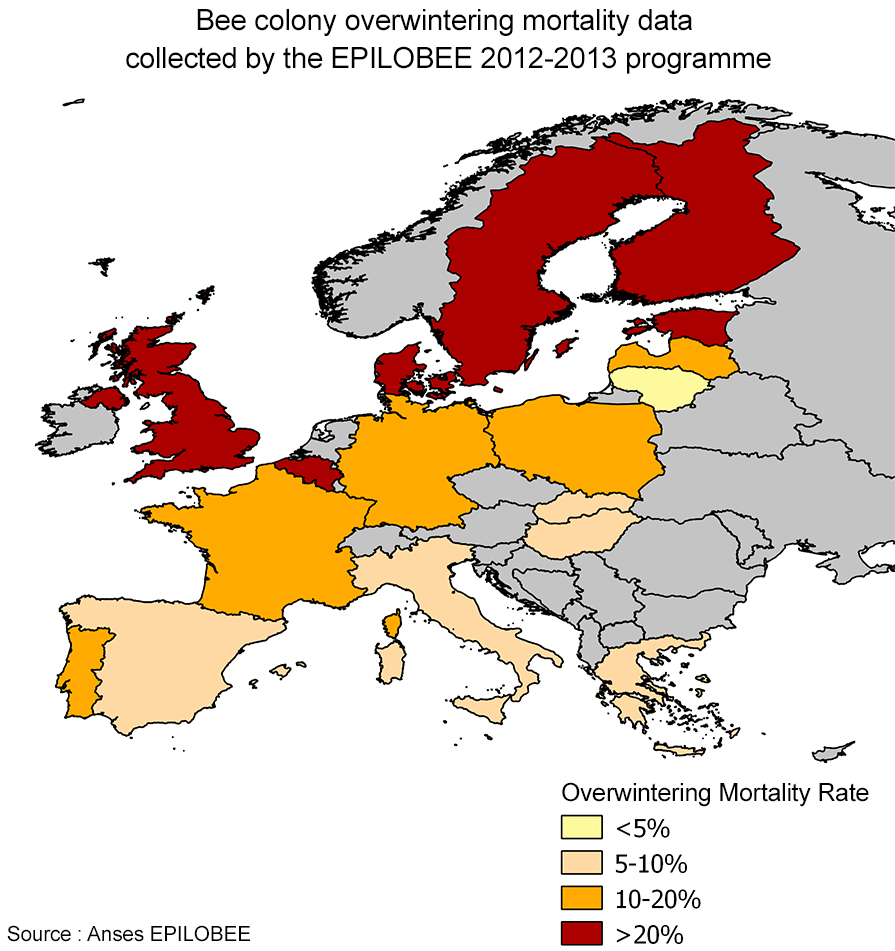
Bee colony mortality: presentation of the initial results of the EPILOBEE European surveillance study
For several years now, weakening and mortality of bee colonies has been observed in many countries. Because of this, for the first time an active surveillance study of bee colony mortality known as EPILOBEEhas been implemented in 17 European Member States. In order to harmonise surveillance procedures, each Member State has devised a surveillance protocol based on the guidelines issued by ANSES’s Sophia-Antipolis laboratory, which is the European Reference Laboratory (EURL) for bee health. This wide-scale study has provided a large amount of data which now makes it possible to estimate mortality rate variability from one geographical area to another in Europe. In addition, an analysis of these data in the future will make it possible to more effectively identify the links between bee colony mortality and certain risk factors (diseases, use of veterinary treatments, etc.). EPILOBEE has made it possible to implement harmonised bee colony surveillance methods which can be used routinely in the future.
For several years now, weakening and mortality of bee colonies has been observed in many countries. ANSES is highly committed to the subject of bee health and has made it one of its priorities because of the essential role played by these pollinating insects in honey production, in the preservation of biodiversity and as an indicator of environmental health.
In this framework, the European Commission has mandated ANSES’s Sophia-Antipolis laboratory, as European Reference Laboratory for bee health, to coordinate an active surveillance study on bee colony mortality. Known as EPILOBEE, the study has been implemented in 17 European Member States. At its request, EPILOBEE has centered its work over the first two years of its operation on the setting up of harmonised criteria for measuring colony weakening and the observation of infectious bee diseases. This European project has not yet incorporated the detection of pesticides into its work, but it should eventually take into account all of the factors potentially responsible for the observed mortality phenomena, as ANSES already does in its Sophia-Antipolis laboratory and in its risk assessment work.
To respond to this request, the ANSES laboratory in Sophia-Antipoliscreated a surveillance protocol which was validated by the European Commission and applied in each of the Member States participating in the study. It also set up a data base for the collection and analysis of these results.
A large amount of data gathered in 17 Member States
31 832 colonies from 3 284 hives in 17 Member States were thoroughly visited between autumn 2012 and summer 2013. In all, 8 572 hive visits were conducted, enabling a large amount of data to be collected.
The mortality rate in both the overwintering period and in the beekeeping season was estimated. Beekeeping practices, information on hives and beekeepers and the clinical signs of the main parasitic and infectious diseases were recorded based on a detailed questionnaire.
The overwintering mortality rate was thus found to vary from 3.5% to 33.6% depending on the country, with a south-to-north geographical distribution. Colony mortality rates during the beekeeping season, lower than those of the overwintering period, ranged from 0.3% to 13.6%.

As concerns bee diseases, American and European foulbrood, two bacterial diseases, had little impact on bee mortality in the 17 participating Member States.
In addition, only a few clinical cases of paralysis due to chronic bee paralysis virus were observed in five of the 17 Member States.
Finally, although 15 suspicious arthropods were collected in seven Member States during the first year of EPILOBEE, none of the analyses for these cases confirmed the presence of either A. tumida (a small hive beetle) or the Tropilaelaps mite, two pathogenic agents causing exotic diseases that do not affect European bees.
In contrast, varroosis (due to the parasite Varroa destructor) was observed in 13 of the 14 Member States providing full data. And finally, over 10% of colonies were affected by nosemosis in four out of the 16 Member States providing full data.
Results and outlook
This wide scale study has generated a huge amount of work involving a large number of stakeholders, from ministries down to those working in the field.
The EPILOBEE study has also provided a significant amount of data: 103 930 laboratory analyses have been stored in a data base and will be analysed in the near future.
These analyses will make it possible to explore the statistical links between bee colony mortality and certain risk factors, including disease prevalence, the use of veterinary treatments, the beekeeping context and other parameters extrinsic to colonies such as diet, season, migration, etc.
This first year of the EPILOBEE study has made it possible to set up a harmonised method for bee colony surveillance that can be used routinely in the future. This will eventually provide data on the dynamics of changes to bee health and enable an objective evaluation of the effects of the risk management measures set up by the Member States.